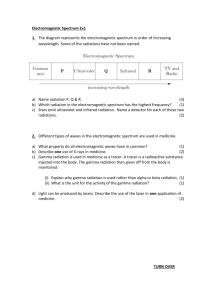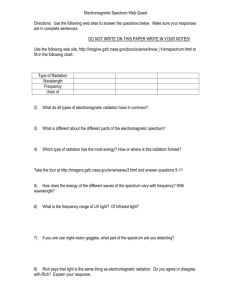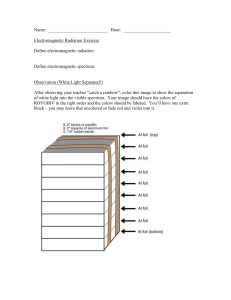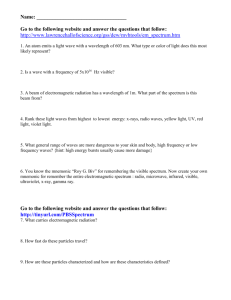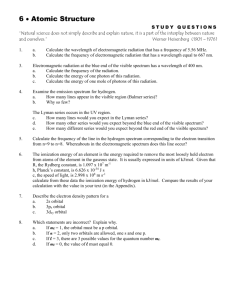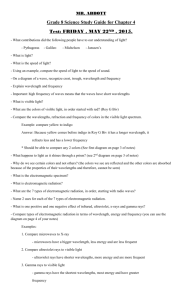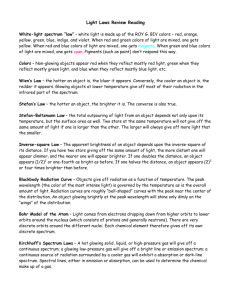Lesson - studentorg
advertisement
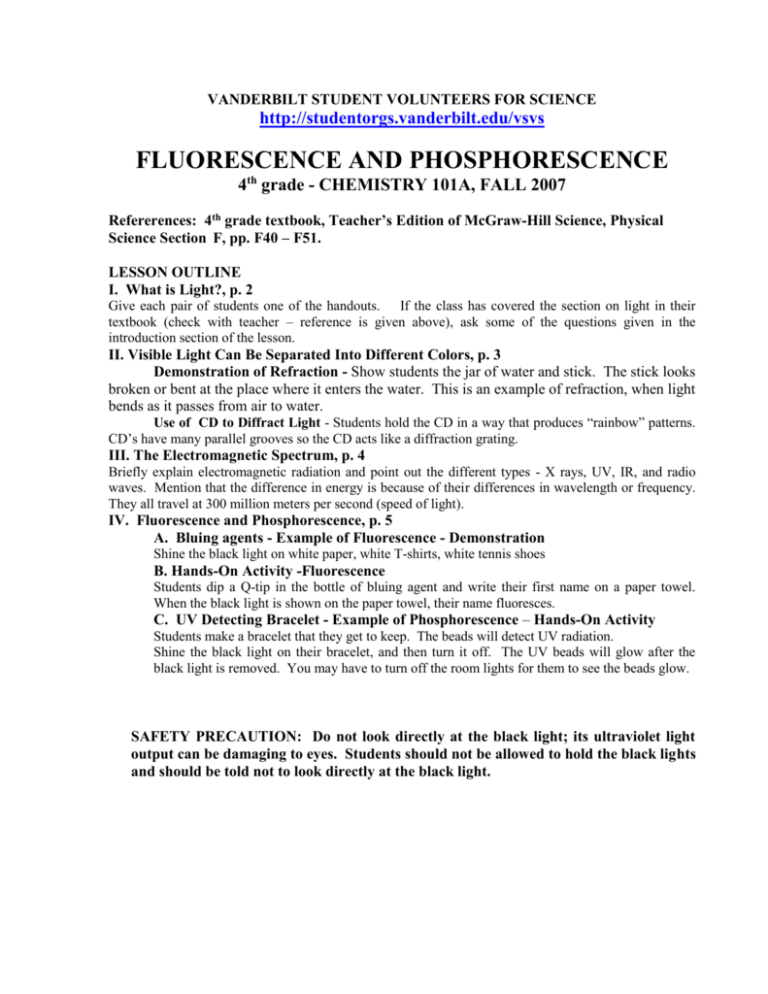
VANDERBILT STUDENT VOLUNTEERS FOR SCIENCE http://studentorgs.vanderbilt.edu/vsvs FLUORESCENCE AND PHOSPHORESCENCE 4th grade - CHEMISTRY 101A, FALL 2007 Refererences: 4th grade textbook, Teacher’s Edition of McGraw-Hill Science, Physical Science Section F, pp. F40 – F51. LESSON OUTLINE I. What is Light?, p. 2 Give each pair of students one of the handouts. If the class has covered the section on light in their textbook (check with teacher – reference is given above), ask some of the questions given in the introduction section of the lesson. II. Visible Light Can Be Separated Into Different Colors, p. 3 Demonstration of Refraction - Show students the jar of water and stick. The stick looks broken or bent at the place where it enters the water. This is an example of refraction, when light bends as it passes from air to water. Use of CD to Diffract Light - Students hold the CD in a way that produces “rainbow” patterns. CD’s have many parallel grooves so the CD acts like a diffraction grating. III. The Electromagnetic Spectrum, p. 4 Briefly explain electromagnetic radiation and point out the different types - X rays, UV, IR, and radio waves. Mention that the difference in energy is because of their differences in wavelength or frequency. They all travel at 300 million meters per second (speed of light). IV. Fluorescence and Phosphorescence, p. 5 A. Bluing agents - Example of Fluorescence - Demonstration Shine the black light on white paper, white T-shirts, white tennis shoes B. Hands-On Activity -Fluorescence Students dip a Q-tip in the bottle of bluing agent and write their first name on a paper towel. When the black light is shown on the paper towel, their name fluoresces. C. UV Detecting Bracelet - Example of Phosphorescence – Hands-On Activity Students make a bracelet that they get to keep. The beads will detect UV radiation. Shine the black light on their bracelet, and then turn it off. The UV beads will glow after the black light is removed. You may have to turn off the room lights for them to see the beads glow. SAFETY PRECAUTION: Do not look directly at the black light; its ultraviolet light output can be damaging to eyes. Students should not be allowed to hold the black lights and should be told not to look directly at the black light. Materials 2 Black Lights (hand-held ones) 1 jar containing water and a stick 1 bag containing 16 small bags with 2 Q tips, 1 CD, 1 diffraction grating 32 1-oz cups, each with 10 UV beads of assorted colors 32 pieces of braid for stringing beads - each one is tied off on one end with one UV bead 1 Roll of white paper towels 1 Lightstick 16 Bottles of Bluing (UltraClorox-2) 1 piece of copy paper 16 handouts - Electromagnetic Spectrum BACKGROUND INFORMATION – this is way too difficult for 3-4th graders to understand, and is for your information only. Electromagnetic radiation is difficult to explain. Avoid detailed explanations of “electromagnetic” if possible. Much of the energy we receive on Earth comes from the sun. Energy travels in waves. Some waves, like light, are visible; other waves are invisible. Examples of invisible waves are ultraviolet (UV), infrared (IR), X rays, and radio waves. Both the visible and invisible forms are called electromagnetic radiation. Radiation is the process of sending out energy waves. A light bulb radiates light. A radio station radiates radio waves. The difference in energy of the different forms of electromagnetic radiation is because of their differences in wavelength or frequency. The speed of all electromagnetic radiation is the same - 300 million meters per second in a vacuum. Since visible light is the most familiar form, this speed is usually referred to as the speed of light. I. WHAT IS LIGHT? The 4th grade textbook has a section on light (see reference at beginning of this lesson). Ask the teacher before class if this section has been covered yet. If the class has studied this section, then you can ask some of the following questions. A. What is light? Light is a form of energy. Light comes from the sun and also from light bulbs and fire. The light you can see comes from the visible spectrum. B. What color is light? Usually white. White is actually made up of all colors. You can see the colors in light when it is refracted, as in a rainbow, or by a prism. • Give each student one of the handouts that include the electromagnetic spectrum and “rainbow”. 2 II. VISIBLE LIGHT CAN BE SEPARATED INTO DIFFERENT COLORS Demonstration of Refraction - Show the students the jar of water and stick. Show them that the stick looks broken or bent at the place it enters the water. This is an example of refraction, when light bends as it passes from air to water. • Ask students to look at the visible light spectrum (the “rainbow”) and identify colors that make up visible light. Visible light is made up of all the colors that the eye can detect. The range of colors, when mixed, looks white to the eye. The three primary colors of light (additive primary colors) are red, green, and blue. When white light passes from one medium (like air) to another (like water), it is refracted. Actually, each color is refracted at a different rate - red is bent the least, while violet is bent the most. When the colors are bent and spread out they form the color spectrum. You can remember the order of the colors by naming the spectrum Roy G. Biv for red, orange, yellow, green, blue, indigo, and violet. (Some students will already know this.) • Ask students where they have seen light broken into its different colors - answers may include a rainbow, a garden sprinkler, light shining through a prism, or on an oil film. Tell students to look at the “rainbow” on their handout. R O Y G B I V White light contains all of the colors in the visible portion of the electromagnetic spectrum. The visible portion is only a small part of the entire spectrum. C. What determines the color of visible light? ANS: the wavelength. D. Which color of light has more energy? Red light or blue light? ANS: blue light Why? Blue light has a shorter wavelength . There are many wavelengths you cannot see. electromagnetic spectrum The visible “rainbow” is just a small part of the 3 Give each PAIR a bag that contains 1 CD and 2 Q-tips USE OF CD TO DIFFRACT LIGHT • Tell the students to pick up the CD and notice the “rainbow” pattern from the room lights. EXPLANATION: CD’s have many parallel grooves so the CD acts as a diffraction grating (a series of slits through which light can pass). The different colors in white light are bent at different rates, so a full spectrum of color can be seen when light is shone onto a CD. III. THE ELECTROMAGNETIC SPECTRUM E. What is the electromagnetic spectrum? ANS: A range of all light waves. Tell the students to look at the electromagnetic spectrum on their handout. F. Which has more energy? Ultraviolet light or infrared light? ANS: ultraviolet H. Which has more energy? Visible light or ultraviolet light? ANS: ultraviolet Mention that ultraviolet radiation (UV), which we can't see, is higher energy radiation next to the violet end of the visible spectrum. The black lights used in today's experiment emit ultraviolet radiation. Since UV radiation is higher energy than visible light, it can damage the eyes if viewed directly. At this point you could also mention that ultraviolet radiation from the sun is the primary cause of sunburn, and the concern about the depletion of the ozone layer in the upper stratosphere is because of its action to remove most of the ultraviolet radiation from sunlight as it passes through the layer. If the ozone layer is depleted, more ultraviolet radiation will pass through to the earth and result in higher rates of skin cancer as well as damage to marine and plant life. Discuss briefly (not more than 3 minutes) the different parts of the electromagnetic spectrum and some of the vocabulary words using the Figures below. Spectrum means bands. The electromagnetic spectrum is made up of bands of different energy of electromagnetic radiation. 4 IV. FLUORESCENCE AND PHOSPHORESCENCE Background information for VSVS members Fluorescence occurs when radiation energy (usually UV) excites electrons in a molecule to higher energy levels and then photons of visible light are emitted when the electrons return to the ground state. For example, the fluorescent light bulb has mercury vapor inside the bulb and a white coating on the inside of the glass bulb. When the bulb is electrified, electrons of the mercury atoms are excited and when they return to the ground state, the emitted photons are absorbed by the white coating and emitted as white light. Phosphorescence generally occurs by the same process as fluorescence except there is a time delay before the electrons eventually return to the ground state so visible light photons continue to be emitted after the radiation (UV or visible) source is removed. Another type of phosphorescence is exhibited in the UV Detecting Beads Activity (Part IV) where the energy change involves a dye molecule absorbing UV energy to produce a different geometric isomer of the molecule. When the UV energy is removed, the color slowly fades as the dye molecule rotates back to the more stable form. A. DEMONSTRATION Tell students you are going to be using a black light. Students are probably familiar with a black light. What they may not know is why it’s called a black light. Tell them that a black light emits ultraviolet radiation – what is seen is the violet visible color, but the light is also emitting UV radiation that is invisible. Since ultraviolet radiation is harmful to the eyes, it should not be viewed directly. Bluing Agents – Fluorescence Demonstration White paper, white tennis shoes, white T-shirts, and even other types of shirts may fluoresce under UV light. • Hold the black light over a piece of white copy paper to show that it fluoresces with a blue light. • Hold the black light over someone's tennis shoes or over a T-shirt or article of clothing, being careful not to shine it in anyone's eyes. EXPLANATION: The fluorescent blue that is observed is caused by bluing that is added to tennis shoes and fabric to make them look whiter. Bluing is also added to laundry detergent to make clean clothes look whiter. These additives are called optical brighteners because they absorb UV light and emit visible light through fluorescence. When optical brighteners are incorporated into textiles, they make the material appear brighter and whiter, thus giving the appearance of being cleaner. B. HANDS-ON ACTIVITY • Give each student a piece of paper towel and a Q-tip. Place the 16 bottles of bluing around the room so that 2 students have access to a bottle. • Tell them to dip the Q-tip in the bluing agent and write their first name on the paper towel. • Hold the black light over their paper towel and their name will be fluorescent blue. 5 The bluing agent in the bottle is UltraClorox 2, which lists as one of its ingredients an optical brightener. This type of additive is used along with detergent when washing clothes. NOTE: Students see blue color immediately after the black light is shone, but the blue color is gone as soon as the black light is removed. (This distinction is important since in the next example, phosphorescence, colors can be seen for several minutes after the black light is removed.) C. MAKING A UV BRACELET – AN EXAMPLE OF PHOSPHORESCENCE • Give each student a cup of 10 UV beads and 1 piece of braid for string beads. • Tell the students to string the beads onto the braid. After they have finished stringing the beads, they should make a bracelet by putting the untied end through the hole in the bead on the tied-off end and tie a knot. • When they are finished, shine the black light on the beads again. (The beads take a few minutes to develop the full color.) Notice that the beads continue to glow after the black light is removed. (If students can’t see the beads glowing, turn off the room lights.) • Tell the students they get to keep the bracelet and to use their UV detecting bracelet to measure the amount of UV radiation on sunny days. They could keep a diary of their results – trying different times of the day and different times of the year - summer vs. winter. Written by: Mel Joesten, Department of Chemistry, Vanderbilt University Pat Tellinghuisen, Program Director, Vanderbilt Student Volunteers for Science 6
